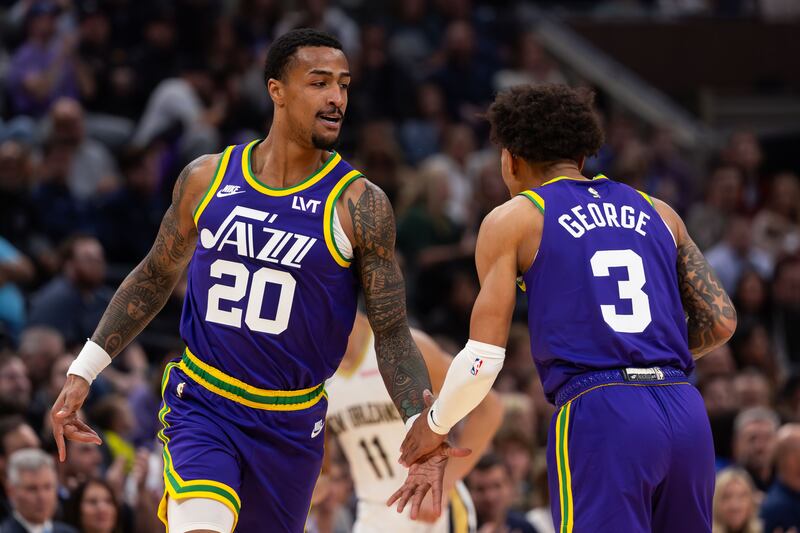Professional athletes are often judged by how consistent they are over time. Are they able to produce at the same level or increase production from one year to the next? If there’s a dip in a player’s production, are they not as good as they once were? Are they past their prime? Were they overrated?
Consistency is certainly important, and can be a great indicator of talent, especially in the NBA. But consistency is incredibly hard to come by. For most NBA players, it’s more important to be adaptable than it is to be consistent, and often, it’s what’s required.
If you look at the 2023-24 Utah Jazz roster, the need to adapt is really the most consistent thing about it.
Lauri Markkanen came to Utah as someone who had been a third option, at best, on his previous two NBA teams. He changed the way that he plays and was able to become the leading scorer and clear No. 1 option for the Jazz.
But in his second season here he’s having to adapt to being the top guy on a scouting report and having teams work really hard to deny him the ball. The fact that he’s maintained a way to consistently score is impressive.
But the ability to adapt is a trait that the role players in the NBA have to be well versed in. Take Kelly Olynyk, for example.
“That’s what it’s gotta be, my role on this team is gonna be fluid,” Olynyk said. “You’ve gotta be able to adjust and adapt to make sure that you can read the game and I can read a room and know what I have to do to leave a positive impact.”
Jazz head coach Will Hardy told Olynyk before the season started that he was going to need Olynyk to be more of a facilitator for the Jazz. Out of necessity and design, Olynyk is taking the least number of shots per game in his entire career, and is averaging a career-low in points per game, but that doesn’t mean that he’s not valuable to the Jazz or that they view his dip in production negatively.
Ochai Agbaji is learning that adaptability might be the most important skill for him to hone. From one night to the next, his minutes, his spot in the rotation, the kinds of defensive assignments he’s given and how aggressive he needs to be on offense are basically a surprise.
“It changes a lot for a lot of guys on this team with the lineups changing and guys being out and coach trying to see different things,” Agbaji said. “I’ve learned, honestly, from other guys being on other teams and being in other situations … talking about their experiences and their different roles that they had on different teams. It shows you that it’s all about situation, opportunity and timing in the league. As soon as you can figure that out, you’ll be successful.”
That’s been the name of the game for nearly everyone on this roster. Kris Dunn had to completely change his offensive game, and the Jazz coaching staff is still trying to figure out what the role is for guys like Collin Sexton and Talen Horton-Tucker.
Simone Fontecchio is finally finding some success in the NBA after dealing with the transition from playing in Europe for so many years and despite being known as a 3-point sniper, he’s adapted into a bit of a 3-and-D hustle player. Ömer Yurtseven came into the league known way more for his offensive game than anything else and now he’s getting minutes with the Jazz because of the defensive physicality that he brings to the table.
“Adapting and staying malleable is the biggest thing that the league requires,” Yurtseven said. “Whatever team you’re moved onto or come from, they can demand different things and being able to adapt to those circumstances is the biggest thing. Being able to do it fast is the priority but being able to do it right obviously goes along with it.”
This doesn’t mean that everyone on this Jazz team has proven that they can adapt and are perfect NBA players. If anything, we’re still in the discovery phase of knowing whether or not many of these players will be able to adapt to what will be asked of them in the future.
We don’t know if John Collins and Walker Kessler will be able to play with each other in the starting lineup and if they can adapt their games to suit the needs of the team. We don’t know if Taylor Hendricks will be able to grow and evolve and adapt to what the NBA requires. And we certainly don’t know what any of the players on this team will be able to do when the Jazz start to make a real push toward contention. Big changes on a roster can really test the adaptability of players and separate those who are capable from those that are not.
This is why we’ve heard Hardy say that he’s less concerned with scoring and more concerned with how players are playing and if they’re building the right kind of habits that will pay off when more or just different things are asked of them.
“Sometimes you have to change and adapt and adjust your game,” Olynyk said. “And it’s not always to what you thought you could have been, or were. … It’s not easy. Not everybody can do it.”
It’s an important thing to keep in mind as the Jazz continue through the early years of this rebuild — the players who have the best chance of a long-term future with the Jazz are the ones that prove that despite the inconsistent nature of the NBA, they are ready, willing and able to change.



